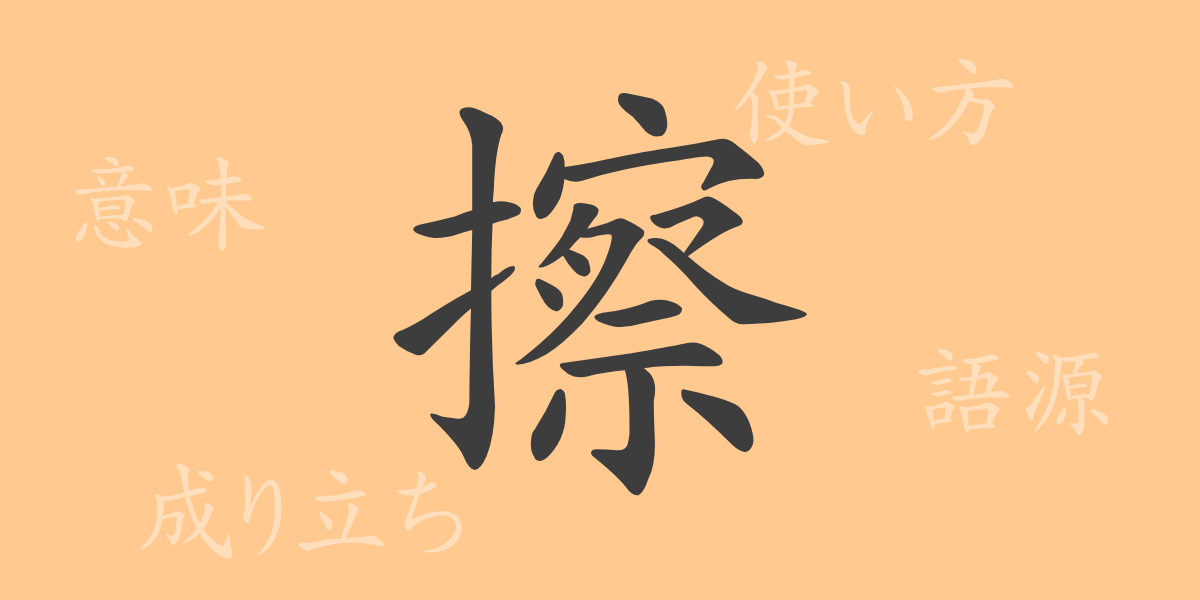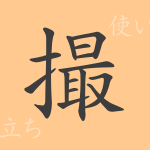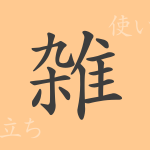Japanese includes numerous kanji characters, each with its own unique history and meaning. The kanji “擦(さつ)” is deeply rooted in our daily lives and is frequently used in various contexts. This article delves into the origins, meanings, usage, readings, stroke count, and radicals of “擦(さつ).” Additionally, it explores idioms, phrases, and proverbs that incorporate this character, revealing the rich world of expression it embodies.
Origin of 擦(さつ)
The kanji “擦(さつ)” represents actions or states arising from contact between hands or objects. It originally combines the radical “扌(てへん)” meaning “hand” and the phonetic component “察(さつ).” “察(さつ)” itself is formed from “宀(うかんむり)” and “祭(さい),” with “祭(さい)” further decomposable into “示(しめす)” and “祀(まつる).” Thus, “擦(さつ)” is constructed from multiple elements, evoking the image of friction and rubbing through contact.
Meanings and Usage of 擦(さつ)
“擦(さつ)” means “to rub,” “to wear down,” or “to create friction.” It specifically refers to phenomena or actions resulting from the movement and contact of objects, such as “wearing down” or “rubbing.” Usage examples include verbs and adjectival verbs like “擦る(する)” (to rub), “擦れる(すれる)” (to be rubbed), and “擦れ違い(すれちがい)” (to pass by each other). It is used both literally for physical friction and metaphorically for differences in opinions, as in “意見が擦れ違う(いけんがすれちがう)” (opinions clash).
Readings, Stroke Count, and Radicals of 擦(さつ)
The kanji “擦(さつ)” has multiple readings, used differently depending on the context.
- Readings: The on’yomi (音読み) reading is “サツ(さつ),” and the kun’yomi (訓読み) readings include “す.る(する)” and “す.れる(すれる).”
- Stroke count: “擦(さつ)” has a total of 17 strokes.
- Radical: The radical of “擦(さつ)” is “扌(てへん).”
Idioms, Phrases, and Proverbs Using 擦(さつ) and Their Meanings
Several idioms, phrases, and proverbs incorporate the kanji “擦(さつ).” Here are a few examples:
- 擦り減らす(すりへらす): To wear down an object through friction.
- 擦り傷(すりきず): A shallow wound caused by rubbing.
- 擦れ違い(すれちがい): A situation where opinions clash or differ.
- 火を擦る(ひをする): To strike a fire, symbolizing efforts to overcome difficulties.
- 擦れると嘘から出る(すれるとうそからでる): A proverb meaning that something used for a long time can appear genuine.
Conclusion on 擦(さつ)
The kanji “擦(さつ)” represents friction and actions arising from contact between objects. Frequently used in daily language, its idioms and phrases highlight the richness of Japanese expression. Understanding the meanings, usage, and cultural background of “擦(さつ)” through this article enriches our appreciation of the language. Learning the history and meanings behind each kanji is a crucial step in using words more meaningfully.

























